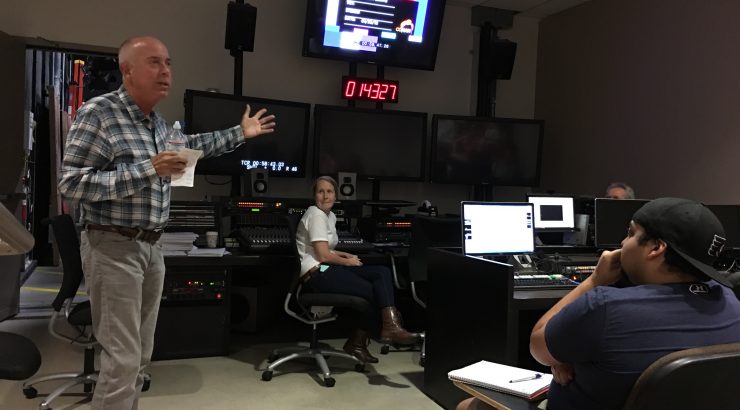On Live TV, Anything Goes…Especially on Conan
September 15, 2016
“You have to be prepared for anything…literally, anything.”
Those were some practical words of advice imparted to students from Allan Kartun, former director of Conan’s late-night shows. Professor Steven Hirsen recently had Kartun come into his Advanced Multi-Camera TV Production class to give the students some advice and talk about his career working with the talk show host.
Kartun left the show in January 2016, after directing Conan for 13 years; he started at Late Night with Conan O’Brien (which he directed over 1,000 episodes), before continuing on to The Tonight Show with Conan O’Brien, and then finally, to Conan.
Kartun told the class that reactions are what make things funny.
“It’s what makes the shot special…it’s not always the joke, but how the other person reacts to it,” he said.
He also touched on the challenges of directing these talk shows, where things change on the fly, often without him knowing about it.
“There are a lot of scripted things…and there are also a lot of unscripted bits. You have to watch the camera monitors to see what is going on. You need to be reactive to the situation, and not look at just the on-air monitor, but at everything.”
One of the aspects that he enjoyed about working for Conan is that he didn’t have to wait for network notes when he needed an answer for something; he just went to Conan.
“If there was a choice, some kind of option, I would just ask, and get my answer immediately.”
Kartun showed clips from an episode of the show, and also brought along copies of his script for the students to follow along. They were able to see all his notes and markings, to see what he had in mind before the cameras rolled…and what actually happened.
While watching it, Kartun called out the shots he took, while explaining the motivation behind them. At one point during the monologue, Conan kept glancing at an audience member, so Kartun had to be on his toes to make sure he got a camera to show what Conan was looking at.
“If we didn’t, it would have been a lost opportunity, and the people at home would have been confused. Like I said before, anything goes.”
When a bit came up with long-time co-host Andy Richter donning a wig to mimic photos of Newt Gingrich, Kartun explained how he controlled the timing and pacing of the piece, therefore controlling the laughs.
“You don’t want to cut away too soon, you don’t want to linger too long…you want just the right amount of time. You also want to make sure you get those reaction shots, too, for bigger laughs. It adds a creative element to the comedy, with pacing.”
During the beginning of Act 2 of the show, Conan apparently ripped his pants, and no one knew. Instead of directly going into a scripted segment, instead, Conan want off-book to talk about his misfortune, and Kartun, yet again, had to be anticipate what was coming next.
“Here’s a close up of the rip, here’s a two shot of the wardrobe person coming in, here’s the reaction shot…it’s all split second timing, quick thinking.”
The interviews, whether with a celebrity guests or live animals (both seen on this particular episode), were made more interesting by the dynamic camera movements that Kartun had his crew make.
“You want to capture the comedy, in both the actions, reactions, and the movements.”
Even something as simple as coming back from break was made more interesting by Kartun and his team.
“Instead of just starting on Conan, we zoomed in on the desk. We did wide shots for guests coming in, and then head-to-toe shots to be more dynamic. We made it more alive.”
Though the students in Hirsen ‘s class have been studying this for awhile, they all walked away with a better idea, and a better appreciation, for the “anything goes” aspect of late night television. Kartun opened their eyes to a whole other level of quick thinking, one that they will take with them in their own careers.


